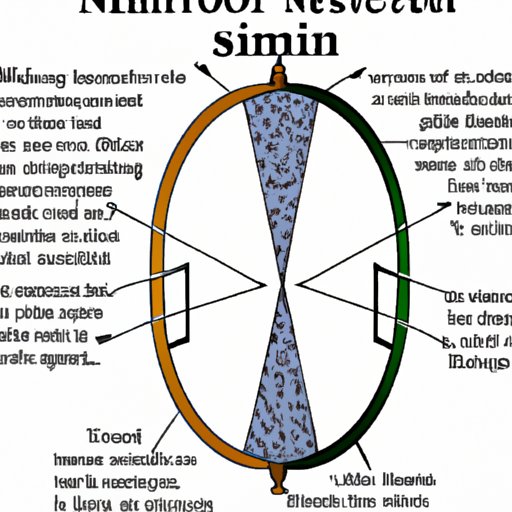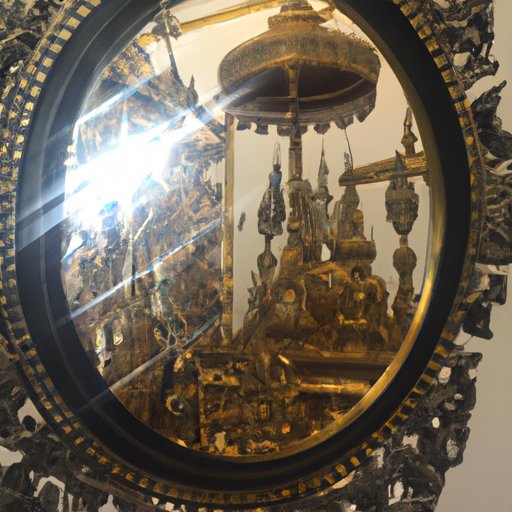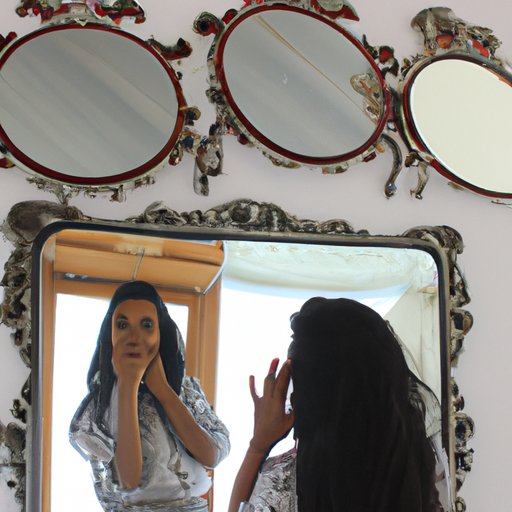Introduction
A mirror is a reflective surface that produces an image of whatever objects it reflects. Mirrors have been used by humans for centuries, but when were mirrors invented? This article will explore the evolution of mirror technology, from ancient times to modern times, as well as its cultural significance throughout history.
Historical Timeline of Mirrors
Mirrors have been around since ancient times. The first known mirrors were polished stones, such as obsidian or quartz, which were used in Egypt and Mesopotamia as early as 6000 BC. In ancient Greece, mirrors were made from sheets of copper and bronze, and were used for personal grooming and for religious rituals. During the Middle Ages (500–1500 AD), mirrors were primarily made from polished steel and other metals, with some being made from glass.
During the Renaissance (1400–1600 AD), mirrors were mainly made from a combination of glass and metal. They were used for both practical and decorative purposes. For example, they were used in homes as well as in churches, where they were often used to reflect light onto the altar. During the Industrial Revolution (1750–1900 AD), mirrors were mass-produced using silvered glass, which allowed them to be produced more quickly and cheaply.
In modern times, mirrors are typically made with float glass, which is created by floating molten glass on a bed of molten tin. This process allows for the production of high-quality, distortion-free mirrors. Additionally, modern mirrors can be made from a variety of materials, including acrylic and plastic.

The Science Behind the Invention of Mirrors
The invention of mirrors was made possible by advances in the field of optics. Optics is the study of light and the behavior of its reflection and refraction. Light is reflected off of a mirror’s surface in a predictable manner, allowing an image to be formed. Reflection occurs when light is bounced off a surface, while refraction occurs when light passes through a material and changes direction.
The earliest mirrors were made from highly polished stones, such as obsidian or quartz. These stones were able to produce clear reflections because of their highly reflective surfaces. Later mirrors were made from metals, such as copper and bronze, which were polished to create a reflective surface. During the Industrial Revolution, mirrors were mass-produced using silvered glass, which allowed them to be produced more quickly and cheaply.
Comparison of Ancient and Modern Mirror Technology
Today’s mirrors are vastly different from those of ancient times. The materials used to make mirrors have changed dramatically over the years, from polished stones to silvered glass and even plastic. Additionally, modern mirrors are able to produce clearer, more accurate reflections than their ancient counterparts.
The production process of mirrors has also changed dramatically, from hand-polishing stones to mass-producing mirrors with float glass. Float glass is created by floating molten glass on a bed of molten tin, which allows for the production of high-quality, distortion-free mirrors. Additionally, modern mirrors can be made from a variety of materials, including acrylic and plastic.

Cultural Significance of Mirrors Throughout History
Mirrors have long held a special place in human culture. Throughout history, mirrors have been used for artistic representation, as well as for use in architecture and daily life. In art, mirrors have been used to symbolize vanity, beauty, and truth. In architecture, mirrors have been used to create spectacular effects by reflecting light. In daily life, mirrors have been used for personal grooming, as well as for checking one’s appearance before leaving the house.
Impact of Mirrors on Art, Architecture, and Daily Life
The invention of mirrors has had a profound impact on art, architecture, and daily life. In art, mirrors allowed for new ways of expressing oneself, as they provided a way to view and interact with one’s own reflection. In architecture, mirrors allowed for the development of new styles, such as Baroque and Rococo, which relied heavily on the use of mirrors to create spectacular lighting effects. In daily life, mirrors increased the convenience of everyday routines, such as getting dressed and doing makeup.

How the Invention of Mirrors Changed the Way People Saw Themselves
The invention of mirrors had a profound psychological effect on people. For the first time, individuals were able to see themselves as others saw them, which had a profound impact on their sense of self-awareness. This newfound self-awareness led to an increase in self-confidence, as people began to feel more comfortable in their own skin.
“The invention of the mirror was more than a technological advance, it was a psychological revolution,” said Dr. John D. Barrow, professor of mathematical sciences at Cambridge University. “It allowed people to look at themselves in a way that was previously impossible.”
Conclusion
This article explored the history and science behind the invention of mirrors, from ancient times to modern times. It also examined the cultural significance of mirrors throughout history, how they changed the way people saw themselves, and their impact on art, architecture, and daily life. From polished stones to silvered glass, the evolution of mirror technology has had a profound impact on society, allowing for increased self-awareness and self-confidence.
(Note: Is this article not meeting your expectations? Do you have knowledge or insights to share? Unlock new opportunities and expand your reach by joining our authors team. Click Registration to join us and share your expertise with our readers.)
